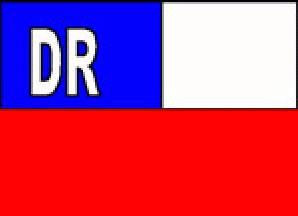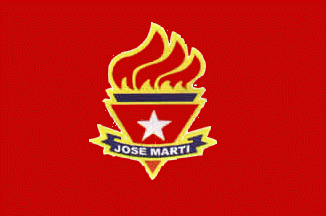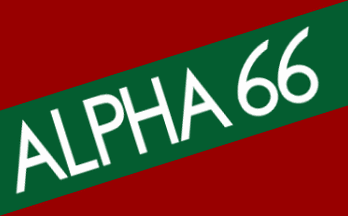![[Cuba 26 July Movement]](../images/c/cu-julio.gif)
image by Ivan Sache , 22 December 1999

Last modified: 2006-02-25 by dov gutterman
Keywords: cuba | july 26 | alpha 66 | brigade 2506 | organizacion autentica | autentica | communist party | omega 7 |
Links: FOTW homepage |
search |
disclaimer and copyright |
write us |
mirrors
See also:
![[Cuba 26 July Movement]](../images/c/cu-julio.gif)
image by Ivan Sache , 22 December 1999
![[Cuba 26 July Movement]](../images/c/cu}m267a.jpg)
image by Maikel Arista-Salado, 4 June 2005
In the center appears frequently a star (white or yellow) or
M26, 26-7, 26J, etc...
Jaume Olle'
The flag of the 26 July Movement, as far as I can remember,
didn't spell 26 de Julio but M-26-7. Perhaps there is two
different versions.
Carlos M. Ramos , 7 Febuary 2000
The July 26th Movement flag appeared in several ways, two of
which were most prominent: one was the red above the black with a
white five point star in the centre, the other was the acronym
'M-26-7' in white letters in the middle, so that the top half
overlapped the red and the bottom the black. Alternately it could
appear with the '26 de Julio' in the middle or the phrase
"Libertad o Muerte" (Liberty or Death) in the middle in
white letters sometimes script, sometimes printed. I have seen
the originals of these versions in the Cuban revolutionary museum
in Havana (formerly Batista's palace).
Greg Dubecky, 18 February 2001
Eons ago, my parents' Caribbean cruise stopped in Havana. It
was shortly after Castro had seized power, and realtions with the
US had not been severed. They brought me back a souvenir flag/pin
which was red over black with a gold "26" on it.
Whether that had any official status or was just an abridged
version of a larger flag (to fit in a lapel) I don't know.
Al Kirsch, 19 February 2001 and 25 May 2002
The 26th of July Movement (Movimiento 26 de Julio) constituted
Fidel Castro's personal political following during the
anti-Batista period, founded 26 July 1956 (?), from which the
Communist Party was formed.
Source: Political Handbook of the World 1997
Jarig Bakker, 26 May 2002
Your source may not be reliable. My memory was that 26 July
was the anniversary of Castro's unsuccessful assault on the
Moncada Barracks. See <www.grossmont.net/mmckenzie/moncada.htm>.
The year was 1953. Cuba's Communist Party is much older than
that.
Al Kirsch, 26 May 2002
On 15 May 1947 Fidel Castro (while a student at the Univerity
of Havana) was a founding member of the Partido Del Pueblo Cubano
(later Partido Ortodoxo), devoted to political reform. In 1952 he
ran for Congress on this party ticket, but Batista cancelled the
elections in a bloodless coup. Castro consequently founded a
revolutionary movement which mounted its first attack (by 100
men) on the Batista regime on 26 July 1953 at Moncada Army
Barracks, Santiago. The attack was a dismal failure.
The few survivors were tried and imprisoned, but Castro's speech
in his defence was a propaganda coup as a call for revolution
("la historia me absolverá"). He was released on 15
May 1955 in a general amnesty. He and a few followers went
to Mexico on 24 June 1955, and in July 1955 organised the
Movimiento Revolucionario 26 de Julio (MR-26-7), named for their
first revolutionary act in 1953. On 30 November 1956, 300
men (led by Frank País) wearing red and black armbands with the
July 26 emblem (the first public display of this insignia?)
attacked police headquarters, the Customs House and the harbour
headquarters in Santiago. Two days later, 80 men led by
Castro in a leaky boat ("Granma") landed in Cuba to
resume to 1953 revolution. This too was a disaster, but 12
survivors fled to the Sierra Maestra and organised the first
guerrilla unit of the 26 July Movement on 18 December 1956.
Twenty-five months later the victorious movement entered Havana
and Batista fled. The former Batista Presidential Palace is
now the Museum of the Revolution and contains "Granma",
and countless artifacts and insignia and flags of the 26 July
Movement. To this day Castro wears a red/black lozenge of the 26
July Movement as his shoulder rank insignia for General of the
Army. (Other rank insignia are Russian-style shoulder
boards.)
During a few speeches in 1961, Castro began to refer to the
revolution as "socialist" and Marxist-Leninist.
On 3 October 1965 the new Communist Party was founded (originally
established in 1925). The First Congress of the Communist
Party met in 1975 and drafted a new constitution.
T.F. Mills, 30 May 2002
In Cuba there is a flag that's seen almost as the National
Flag but given scant attention as it doesn't enjoy the status and
rank of the national flag. I’m talking about the flag
of the 26 July Movement – the organization that deposed the
dictator Batista, and led by Fidel Castro (1953-1959).
The Movement adopted this name as it was on 26 July 1953 that the
struggle began to evict the tyrant from the Presidency. On that
day occurred the assault on regime strongholds of Moncada and
Carlos Manuel de Cispedes – the former the second most
important in the country. This historic event made Fidel a
household name in Cuba. From that point to the final
victory, the 26 July Movement become known the length and breadth
of the country, its emblem stuck on doors and windows as a sign
of approval. That custom stuck, and on anniversaries of the
Revolution, both flags are hoisted together.
The flag is used de facto, that is, it has no official
standing at law but is used informally as a sign of loyalty to
the Government and a signal of approval.
In many workplaces, offices and so on, it often appears together
with the national flag, in many cases of equal height and size
with the national flag, notwithstanding that it has no other
status than that of an historical curiosity that had its time and
place in the struggle against Batista.
To note is its similarity with the flag of the Sandinistas – although with
colours reversed.
Maikel Arista-Salado (translated by Tony Burton),
21 September 2004
Currently this flag is of official use, almost at the same
level as thre national flag. It is also shown on the site of the
Heralatin School of Cuba at <heralatin.t35.com>.
Maikel Arista-Salado (translated by Esteban Rivera),
3 June 2005
At Ebay there were few Cuban Communist flags:
1) at <cgi.ebay.com/item=1076138959>
:
This flag was adquired in
Cuba a while ago. It is made of fabric, the letters are sew to
the flag and the center figure of Lazaro Pe-a (he was minister of
CTC (the Cuban Workers Union) back in the 70's.He died long time
ago.The faces around his portrait are all painted on the fabric
(interesting effect) ) and it says in espanish "And the seed
sprouts" on the other
side the embroided flag of the CTC is beautifully embroided
and still very bright. The flag measures 48"x30" and
except for a yellowish tone in some parts due to age, it is in
very good condition.
2) at <cgi.ebay.comitem=1076121595>
:
This flag was adquired in
Cuba a while ago. It is made of fabric, the letters are sew to
the flag and the center figure of Fidel Castro and Camilo
Cienfuegos is beautifully embroided and still very bright. The
flag measures 48"x30" and has some dirt but no rips.
Both sides have the same design. The curious part of this flag is
the historical significance. In 1970, the cuban government took
most workers to the cane fields because they projected the
largest sugarcane harvest in history (10 million tons of sugar)
They only got to 8.5 millions and the economy went down the
toilet because the rest of the industries were niglected. Every
time they reached to a new million of tons they would make these
flags and distributed to the best sugarcane cutters (a BRIGADE).
Now, this flag was prepared to give to the first BRIGADE to get
to the 9th million. BRIGADA NONA-MILLONARIA. So this flag never
had the use it was intented and probably the reason it survived
until today. The XVI anniversary is based on the July 26 of 1956
attack to Cuartel Moncada and the beginning of the Revolution.
3) at <gi.ebay.com/item=1076135114>
:
This flag was adquired in
Cuba a while ago. It is made of fabric, the letters are sew to
the flag and the center figure of Lazaro Pe-a (he was minister of
CTC (the Cuban Workers Union) back in the 70's. He died long time
ago) is beautifully embroided and still very bright. The flag
measures 48"x30" and except for a yellowish tone in
some parts due to age, it is in very good condition.
Rob Raeside, 21 Febuary 2002
Not sure if it was official but I have seen a pictures of
Cuban revolutionaries that used as a upper shoulder badge a flag
divided horizontaly red over black with a yellow star in the
middle.
Marc Pasquin, 6 March 2002
I recall a button in the shape of a flag which was red over
black with a yellow "26" (not a star). My parents
brought it back from Cuba not long after Castro took over. Is
this an alternative design to the one with the star, or is it
just a tourist souvenir?
Al Kirsch, 6 March 2002
That was probably the 26 July Movement flag
that was used by the revolutionaries. Initially, many of them
(including Castro) were not communist. The Communist party played
a large part in trying to get these guys to become communist in
the beginning, but failed until later.
Rob Raeside, 6 March 2002
Cuba has a rich flag heritage, and markedly so over the last
50 years. Society has become more flag conscious
(“vexilogizado”). Trade Unions all have their
flags, and so do other mass oragnziations, that in reality
function as political organizations properly so-called in these
sense that they are the means of mobilizing all or most of the
population. The greater number of these flags of “Mass
movements” have a red field, given the historic association
with the communists. I would personally be very interested to
know if the Soviets were the first to adopt that usage, or
whether there were historical antecedents.
Most of these flags have a red field with the organization emblem
in the centre – eg the National Pioneers organization and
those of Committees for the Defense of the Revolution (entities
for political repression but with a popular façade).
Maikel Arista-Salado (translated by Tony Burton),
21 September 2004

image resized from <www.cubaencuentro.com>
At <www.cubaencuentro.com>
there is an image of flag titled: "Bandera del Directorio
Revolucionario"
Any more information about this flag?
Dov Gutterman, 4 October 2002

José Marti Pioneers' Association
image by Maikel Arista-Salado, 21 June 2005
One of the last remnants of the Pioneer organizations which
were to replace scouting in the Soviet system. Here is the flag of the José
Marti Pioneers' Association of Cuba.
Chrystian Kretowicz, 9 January 2002
Pioneers Organization "Jose Martí" - this
organization groups the primary and elementary education students
and those of high school, until 9º degree.
This one is the ordinary flag, the "protocolar" one
have a yellow fringe imitating silk, in all the edge, is used
preceded of Union de Jovenes Comunistas (UJC - Something like
Young Comunist Union) and the one of Communist Party of Cuba
(PCC), and all, naturally, of the National flag. It's, although
not officially, an organization with political intentions,
controlled by Young Communist Union. The initiation in
these organizations takes place with a traditional act which
consist of giving, depending the student's category, a
neckerchief, blue or red, that ties to the neck and since
that moment it form a part of the scholastic uniform.
It's very exciting. I made it twice, first when I received blue
neckerchief, and second when I received the red one, because I
had passed to 4th degree, that is a new category; in high school
the neckerchief is repalced by a symbol consisiting in the bars
with colors of the national flag and to the right, the
"Che's" (Ernesto Guevara de la Serna) signature, the
symbol measures approximately 1.5 cm by 10 cm in some cases and
is the symbol of High school. is sticks directly on the white
shirt of the uniform.
Maikel Arista-Salado, 21 June 2005
![[Cuba 26 July Movement]](../images/c/cu}mourn.gif)
image by Maikel Arista-Salado, 22 February 2006
I happened to see on BBC TV news earlier this week a report
that Cuba has erected a monument of 138 flags in front of the
U.S. mission in Havana. There are number of reports and pictures,
including <www.theage.com.au>
and <news.xinhuanet.com>.
The flags have a black field with a single five-pointed white
star in the middle.
André Coutanche, 10 February 2006
The mourning flag (bandera luctuosa) was hoisted on
February 6th, 2006 at 6:00 p.m.; 138 mourning flags were hoisted
in front of the US Interests Section in Havana, representing
"a small portion of many men and women killed by terrorists
attacks organized by the United States of America". The flag
is black with a white star in its center. The black colour
represents the mourning of the Cuban people and the white star
its dignity. The Cuban mourning flags remain hoisted 24 hours a
day and they are never lowed not even in the night. This flag has
the same proportion than the national flag.
Maikel Arista-Salado, 22 February 2006
The reason the flags are not lowered, not even in the night,
is because their primary purposes is to obscure the illuminated
scrolling message board which had been erected on the front of
the building occupied by the United States interest section in
January. In my opinion, this is not a funeral flag (although it
could perhaps be termed a memorial flag). It is quite clear from
reliable and credible news sources that the display of these
flags is part of an escalating situation between the United
States and Cuba. Clearly, these are political and propagandist
flags, as well as any other meaning which might have been
subscribed to them by those who erected them, or by those who
have lost relatives.
Source: "Black flags block US sign in Cuba" -
British Broadcasting Corporation News web site, 7 February 2006
at <news.bbc.co.uk>.
Colin Dobson, 22 February 2006
![[Cuba 26 July Movement]](../images/c/cu}fpm.gif)
image by Dov Gutterman, 8 October 2005
Flag of Free People's Movement at <www.freepeoplesmovement.org>.
Same flag used also by the Revolutionary Youth at <www.freepeoplesmovement.org/ry>.
doubleinfiniti, 12 September 2005
About the last flag, I must say it's not a Cuban flag. it has
never been used in my country.
Maikel Arista-Salado, 7 February 2006

image by Eugene Ipavec, 8 December 2005
.gif)
Coat of Arms
image from <www.alpha66.org>
Anti-Cuban Guerrilla Movement "Alpha 66" official
flag at <www.alpha66.org>.
E. R., 24 May 2001
Alpha 66 is a Cuban political group who did carry guerrilla
expeditions not againts Cuba but against the communist regime.
None of his members consider himself anti-Cuban, actually they
consider themselves very good Cubans by opposing a dictatoship.
Juan Martin, 1 April 2002
The emblem of the movement was designen by Cuban artist José
María Mijares. This armed movement has offices in Florida,
California, New York and New Jersey.
E. R., 8 December 2005

image from <www.brigada2506.com>
, located by Esteban Rivera
Anti Castro group "2506 Brigade" flags at <www.brigada2506.com>
and <www.autentico.org>.
E. R., 14 January 2002
![[Cuba 26 July Movement]](../images/c/cu}cf4.gif)
image by Jaume Ollé and Eugene Ipavec, 21
September 2005
I have some information on an opposition Cuban group settled
in the United States that calls itself "Comandos F-4".
The source is an article in Spanish on the "Miami
Times" that appeared in 2003 witha story on the group. On
the newspaper artcile as well as on the internet, the name of
Rodolfo Frometa appears as the frontman of this group.
E. R., 7 April 2004
The flag is green-red-black-green. The hoist triangle is blue.
Information on this group as translated from <www.comandosf4.org>:
"The F4 commandos are a group of men, women and children who
dream and fight for the freedom of Cuba.
F4 commandos are worthy, combative, fragile, painful and
self-sacrificing, a weapon always aimed toward the horizon,
seeking the perfect target to liberate Cuba from all the fears,
all the pain, all the betrayals of the tyrant that humiliates it,
opresses it, jails it and murders it. The F4 commandos are a
dream full of love for their motherland, and a great sacrifice
for all those that have joined it and have dedicated their souls
to its great cause: to see their people free again of their
chains.
In genetics, "F4" means the union of two components to
make of them something better, in this case the best of those in
exile, united for the best of the Cuban people."
E.R. and Eugene Ipavec, 21 September 2005
In a breeding scheme, F4 means the fourth generation (I guess
that F stands for fertilization) of descendants after the initial
crossing between two parents P, which gave the F1 generation.
Using individuals from the F1 as parents gives F2 etc. Whether
the result of the cross is better than the mean of the parents
(heterosis effect) depends on the selected character and on its
genetic determinism.
Ivan Sache, 30 August 2005

by Ivan Sache , 22 December 1999
I just stumbled on <www.autentico.org>
. It is the site of the 'Organización Auténtica' - I don't know
whether it is Cuban or not.
Jarig Bakker , 22 December 1999
It is listed by Smith (1975) [smi75c]
as a Cuban party. I guess it is a satellite of the Cuban
communist party or one of the pseudo-non-communist parties, if
any.
Ivan Sache , 22 December 1999
In regards to the Partido Auténtico, it was a political party
prior to 1959 when Castro took power. It was the rival of the
Partido Ortodoxo with which Castro sympathized.
Carlos M. Ramos , 7 Febuary 2000
The Autentico Party was a populist, almost social democrat
party created in the 1930's. They had two elected pressidents
(Grau 1944-48. and Prio 1948-52, the second was ousted by a
pustch). While much can be said about his leadership (or lack of)
the Autentico gobernments respected free enterpise, free press,
didn't try to control unions, allowed the existence of political
parties (including the comunist one, called at the time PSP
Partido Socialista Popular).
Juan Martin, 1 April 2002
Cuban Exiled Armed Organizations can be reached at <cuban-exile.com>.
OMEGA 7 (Anti-castro brigade) at <cuban-exile.com/doc0011.htm>.
Esteban Rivera, 14 January 2002
Does anyone know anything about that unusual flag that the
demonstrators surrounding Elian Gonzalez' home in Miami, Florida
have been using?
Description of the flag:
Just like the Cuban national flag but with the addition of
crossed olive(?) branches underneath the star near the hoist.
Ben , 8 April 2000
I was told that the Crossed olive branches are added when
confronting tyrants. That it is ordered in the Cuban
constitution of 1940.
RepofMiami@cs.com, 14 January 2002